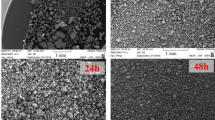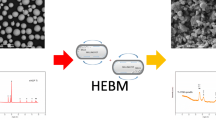Abstract—
Zirconia has been prepared by exothermic synthesis from solutions, using nitrates and a glycine–urea reducing agent. The phase composition of the synthesis products and the relationship between the zirconia polymorphs have been determined as functions of the amount and nature of the stabilizing oxide and the heat treatment temperature. The addition of 5% calcium and yttrium has been shown to ensure the preparation of a material with partial stabilization of tetragonal zirconia (50–70%) or complete stabilization of the tetragonal phase. The synthesized zirconia consists of flaky macroparticles of various sizes, which in turn consist of rounded nanocrystalline particles up to 100 nm in size. The crystallite size is 10–20 nm.







Similar content being viewed by others
REFERENCES
Balkevich, V.L., Tekhnicheskaya keramika: uchebnoe posobie dlya vuzov (Engineering Ceramics: A Learning Guide for Higher Education Institutions), Moscow: Stroiizdat, 1984, p. 256.
Andrianov, N.T., Balkevich, V.L., Belyakov, A.V., et al., Khimicheskaya tekhnologiya keramiki: uchebnoe posobie dlya vuzov (Chemical Technology of Ceramics: A Learning Guide for Higher Education Institutions), Guzman, I.Ya., Ed., Moscow: RIF Stroimaterialy, 2003, p. 496.
Strelov, K.K. and Mamykin, P.S., Tekhnologiya ogneuporov (Technology of Refractories), Moscow: Metallurgiya, 1978, p. 376.
Boch, P. and Nièpce, J.-C., Ceramic Materials: Processes, Properties and Applications, New York: Wiley-I-STE, 2007, p. 592.
Carter, C.B. and Norton, M.G., Ceramic Materials: Science and Engineering, Springer Series in Chemical Physics, New York: Springer, 2007, p. 716.
Rutman, D.S., Toropov, Yu.S., and Pliner, S.Yu., Vysokoogneupornye materialy iz dioksida tsirkoniya (Highly Refractory Zirconia Materials), Moscow: Metallurgiya, 1985, p. 136.
Primachenko, V.V. et al., Highly refractory stabilized zirconia crucibles produced by vibration casting for induction skull melting of platinum group metals, Lit’e Metall.: Nauchno-Proizvodstv. Zh., 2012, no. 3 (67), pp. 166–168.
Zhigachev, A.O., Golovin, Yu.I., Umrikhin, A.V., Korenkov, V.V., Tyurin, A.I., Rodaev, V.V., and D’yachek, T.A., Keramicheskie materialy na osnove dioksida tsirkoniya (Zirconia-Based Ceramic Materials), Golovin, Yu.I., Ed., Moscow: TEKhNOSFERA, 2018, p. 358.
Sornakumar, T., Advanced ceramic composite tool materials for metal cutting applications, Key Eng. Mater., 1996, vol. 114, pp. 173–188.
Dow Whitney, E. and Vaidyanathan, N., Engineered ceramics for high speed machining, ASM Int. Conf. Proc., 1987, pp. 77–82.
Charles, W., Ceramic cutting tools update, Manuf. Eng., 1988, vol. 100, pp. 81–86.
Mahato, N., Gupta, A., and Balani, K., Doped zirconia and ceria-based electrolytes for solid oxide fuel cells: a review, Nanomater. Energy, 2012, vol. 1, no. 1, pp. 27–45.
Zhou, X.-D. and Singhal, S.C., Fuel cells. Solid oxide fuel cells: overview, Encyclopedia of Electrochemical Power Sources, 2009, pp. 1–16.
Seongkook Oh, Junsuk Park, Jeong Woo Shin, and Byung Chan Yang, High performance low-temperature solid oxide fuel cells with atomic layer deposited-yttria stabilized zirconia embedded thin film electrolyte, J. Mater. Chem. A, 2018, pp. 7401–7408.
Ossama Saleh Abd El-Ghany and Ashraf Husein Sherief, Zirconia based ceramics, some clinical and biological aspects: review, Future Dent. J., 2016, vol. 2, pp. 55–64.
Chevalier, J. and Gremillard, L., Ceramics for medical applications: a picture for the next 20 years, J. Eur. Ceram. Soc., 2009, vol. 29, no. 7, pp. 1245–1255.
Dearnley, P.A., A review of metallic, ceramic and surface-treated metals used for bearing surfaces in human joint replacements, Proc. Inst. Mech. Eng., Part H, 1999, vol. 213, no. 2, pp. 107–135.
Kauppi, E.I., Rönkkönen, E.H., Airaksinen, S.M.K., et al., Influence of H2S on ZrO2-based gasification gas clean-up catalysts: meoh temperature-programmed reaction study, Appl. Catal., B, 2012, nos. 111–112, pp. 605–613.
Zhang, X., Su, H., Yang, X., and Zhang, X., Catalytic performance of a three dimensionally ordered macroporous Co/ZrO2 catalyst in Fischer–Tropsch synthesis, J. Mol. Catal. A: Chem., 2012, no. 360, pp. 16–25.
Signoretto, M., Menegazzo, F., Contessotto, L., et al., Au/ZrO2: an efficient and reusable catalyst for the oxidative esterification of renewable furfural, Appl. Catal., B, 2013, no. 129, pp. 287–293.
Nikiforov, S.V., Kortov, V.S., Kiryakov, A.N., Konev, S.F., and Men’shenina, A.A., Increasing the luminescence yield of zirconia, Tech. Phys. Lett., 2017, vol. 43, no. 12, pp. 1074–1076.
Kiisk, V., Puust, L., Utt, K., Maaroos, A., Mandar, H., Viviani, E., Piccinelli, F., Saar, R., Joost, U., and Sildos, I., Photo-, thermo- and optically stimulated luminescence of monoclinic zirconia, J. Lumin., 2016, vol. 174, pp. 49–55.
Gorelov, V.P., High-temperature phase transitions in ZrO2, Phys. Solid State, 2019, vol. 61, no. 7, pp. 1288–1293.
Zavodinskii, V.G., Mechanism underlying the phase stability of magnesium- and calcium-doped zirconia, Perspekt. Mater., 2005, no. 2, pp. 5–9.
Okovityi, V.V., Choosing oxides for zirconia stabilization in the fabrication of thermal barrier coatings, Nauka Tekh., 2015, no. 5, pp. 26–32.
Fenech, J., Viazzi, C., Bonino, J.-P., et al., Morphology and structure of YSZ powders: comparison between xerogel and aerogel, Ceram. Int., 2009, vol. 35, pp. 3427–3433.
Krivtsov, I.V., Ustimenko, A.V., Il’kaeva, M.V., and Avdin, V.V., Synthesis of zirconia nanoparticles via thermal decomposition of a zirconium complex with citric acid, Vestn. YuUrGU, Ser. Khim., 2013, vol. 5, no. 4, pp. 38–41.
Huang, W., Yang, J., Meng, X., Cheng, Y., Wang, C., Zou, B., Khan, Z., Zhen, W., and Cao, X., Effect of the organic additions on crystal growth behavior of ZrO2 nanocrystals prepared via sol–gel process, Chem. Eng. J., 2011, vol. 168, pp. 1360–1368.
Tok, A.I.Y., Boey, F.Y.C., Du, S.W., and Wong, B.K., Flame spray synthesis of ZrO2 nano-particles using liquid precursors, Mater. Sci. Eng., B, 2006, vol. 130, pp. 114–119.
Duran, C., Jia, Y., Sato, K., Hotta, Y., and Watari, K., Hydrothermal synthesis of nano ZrO2 powders, Key Eng. Mater., 2006, vols. 317–318, pp. 195–198.
Liao, J., Zhou, D., Yang, B., Liu, R., and Zhang, Q., Sol–gel preparation and photoluminescence properties of tetragonal ZrO2:Y3+,Eu3+ nanophosphors, Opt. Mater., 2012, no. 35, pp. 274–279.
Wang, S., Zhai, Y., Li, X., Yang, L., and Wang, K., Coprecipitation synthesis of MgO-doped ZrO2 nano powder, J. Am. Ceram. Soc., 2010, no. 89, pp. 3577–3581.
Nogami, M. and Tomozawa, M., ZrO2-transformation-toughened glass-ceramics prepared by the sol–gel process from metal alkoxides, J. Mater. Sci. Lett., 2010, no. 69, pp. 99–102.
Purohit, R.D., Saha, A.S., and Tyagi, A.K., Combustion synthesis of nanocrystalline ZrO2 powder: XRD, Raman spectroscopy and TEM studies, Mater. Sci. Eng., B, 2006, vol. 130, nos. 1–3, pp. 57–60.
Jafari Ayoub, Z., Jafar Tafreshi, M., and Fazli, M., Effect of calcination temperature on the alumina–zirconia nanostructures prepared by combustion, Synth. JNS, 2013, vol. 2, pp. 457–461.
Boobalan, K., Vijayaraghavan, R., Chidambaram, K., Mudali, U., Mudali, K., and Raj, B., Preparation and characterization of nanocrystalline zirconia powders by the glowing combustion method, J. Am. Ceram. Soc., 2010, vol. 93, no. 11, pp. 3651–3656.
Denisova, E.I., Ustyuzhaninova, I.A., Kartashov, V.V., Volkovich, V.A., Chernetskiy, I.V., and Vlasov, A.V., Glycine–nitrate combustion synthesis of ZrO2–Y2O3 nanopowders, Adv. Mater. Res., 2015, vol. 1103, pp. 37–43.
Mimani, T. and Patil, K.C., Solution combustion synthesis of nanoscale oxides and their composites, Mater. Phys. Mech., 2001, no. 4, pp. 134–137.
Author information
Authors and Affiliations
Corresponding author
Additional information
Translated by O. Tsarev
Rights and permissions
About this article
Cite this article
Podbolotov, K.B., Khort, N.A. & Izobello, A.Y. Phase Composition and Structure of Zirconia-Based Ceramic Materials Prepared by Exothermic Synthesis. Inorg Mater 57, 1067–1076 (2021). https://doi.org/10.1134/S0020168521100113
Received:
Revised:
Accepted:
Published:
Issue Date:
DOI: https://doi.org/10.1134/S0020168521100113




